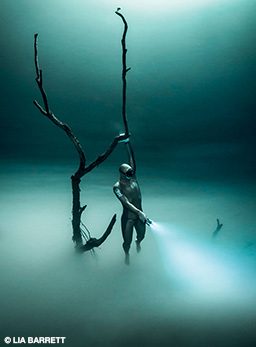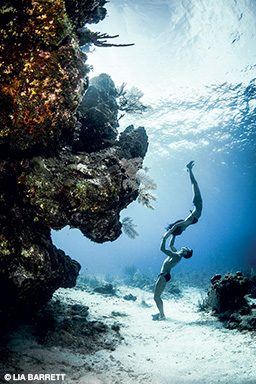Photographing freedivers underwater is like wildlife photography with a delightful twist. In essence you are working with a very graceful, compliant animal with whom you have the luxury of collaborating and directing.
Photographing humans underwater is unique because you are not capturing them in their natural habitat, which presents an enormous set of challenges, the biggest of which are the responsibilities and risks involved in breath-hold diving. When photographing a person in a conventional studio, you are not looking for signs of oxygen deprivation. Underwater, this added factor makes planning, communication and safety precautions crucial before you even capture one frame.
There are risks with any underwater activity, but capturing images of people in the sea is a phenomenal way to connect your audience with the ocean. I approach my images as if I am forging a visual bridge between someone who will probably never dive or perhaps even see the ocean and the underwater world. It is too easy to disregard that which you cannot see or fathom, so making a connection is an important component for fostering a desire to preserve and protect our waters.
Using freedivers instead of scuba divers is especially effective. The impression of an individual underwater without a scuba tank triggers a visceral reaction in our brains: “Something isn’t right here. How do they do that?” or “That must be Photoshopped” are common reactions to an image of a freediver, especially one wearing everyday clothing. The incongruence with our instincts is poignant, and it is one reason freedivers make evocative subjects. Regardless of the freediver’s skill, the planning involved requires a great deal of care, communication and foresight to have a fruitful and safe shoot.
Preshoot Planning
In preparation for a shoot, it is vital to assess the location while considering the skill of the freediver. Is there a current or the possibility of a current? At what depth are you shooting? Are animals present? If I am shooting in a cenote at 90 feet, I might not have any issues with current or wildlife, but I have to decide whether the freediver is going to breath-hold during the entire shoot or come down on scuba gear assisted by other trained divers and given air throughout the shoot. Few folks in the world can repeatedly freedive to 90 feet and hang out for two to three minutes of shooting time, surfacing only for recovery and breathe-up time between dives.

If you are unfamiliar with the skill of your subject or are at all concerned, then choosing a shallow and calm location or planning for assisted air might be prudent. Also consider the bottom time for the photographer and scuba team and the spare air needed for everyone, including freedivers. Creating a full assessment of the environment and the skill of the team is crucial.
Other matters to consider before your shoot are props, wardrobe and gear. Are the freedivers using fins? A mask? Will they be in a wetsuit or clothes? Divers wearing regular clothes will likely get cold more quickly than if wearing a wetsuit, which leads to shorter dive times and more energy expelled. If a prop is involved, who will manage it, and where will it be when the divers descend? Will the freediver be wearing weights? Can weights be visible? If not, where can you hide them? Planning these details is important and can prevent the need to troubleshoot during a dive.
Scuba divers generally do not have to physically prepare themselves the way freedivers do. A good night’s sleep is important. A heavy night of boozing will kick a freediver in the tush the following day, so preparedness extends beyond just the dive.
After you have considered and planned all the pieces of the shoot, have a full team briefing. In the mayhem of preparation, remember to convey what you are trying to achieve with the shoot. Is the freediver to express an emotion, make a gesture, or show scale? Is there a story involved or a statement that you are trying to convey? Making sure your entire team is on board with both the conceptual program and the logistical details will make for a smoother experience.
Underwater Communication
Underwater communication is challenging. When you are in shallow water you can pop to the surface and chat if you need to. But if you are hanging out at the bottom of the ocean with a dozen sharks swirling around you, then perhaps you don’t want to waste your time ascending and descending to communicate instructions.
When I first started working with underwater models, most of them would politely tell me that my hand signals weren’t clear. In my mind I was making total sense, but my thoughts were not translating into actionable communication. I wasted precious shooting time and frustrated my subjects and myself. Now I discuss a few key signals with both the freediver and my safety team before every shoot, remembering that not every freediver is a scuba diver, so they are not always familiar with signals that seem innate to seasoned bubble blowers.
The key signals are up, down, side to side, stop, stay, swim, stand and look in a certain direction, end the dive, problem, and repeat. Beyond a simple signal, I often end up doing the position that I want them to imitate. If they are breath-hold diving, I use their initial dive to show them where I want them to be and in what pose. It often feels like charades, so it’s helpful to work with your model over several shoots to get to know one another’s style.
Be Ready for the Shot

If your freediver is doing the entire shoot on breath-hold, you have a lot of time to think. Between each dive, freedivers must recover and breathe up to restore the oxygen in their bodies for their next dive. This process can take several minutes, depending on the length of their previous dive, so it is a great time to transition to new shooting locations, look for alternative light angles and make sure your safety team is with you (and behind you for when the freediver descends). I also take a moment to check my previous shots to make sure they are not under- or overexposed. Dials sometimes get moved while shooting, and photographers do not have any spare time to scrutinize each frame while in the throes of snapping a freediver, so between dives is a great time to review camera settings.
When freedivers are breathing up, they lie flat on their backs, or on their stomachs while using snorkels, and relax their bodies as much as possible to preserve energy. When they flip over or remove their snorkel, they are ready to descend. At that point my finger is on the shutter release, the composition is in my viewfinder, and I am ready to go. When the freediver arrives at the appointed spot, I fire off as many shots as I can, bracketing a bit for light adjustments. The adrenaline is flowing, and you quickly use air as you maneuver to different angles to capture a variety of images. It is important to check your air when the freediver begins to ascend. Don’t skip your recovery and safety checks.
Limited Mobility
If freedivers glide through the water like a hot knife through butter, then a scuba diver moves more like a knife through a jar of stiff, crunchy peanut butter. We are neither graceful nor particularly speedy. If we were able to glide around as fluidly as a freediver, covering more ground underwater, the shoot would be more efficient.
While breath-hold diving has its advantages, there are some cons to both the photographer and the subject using breath-hold. You expel more energy and use more oxygen, and you don’t have the time in between breaths to reassess your environment for new angles for shooting, patches of coral to swim near and interesting compositions to capture. Unless you are shooting the same location over and over and know it well, scuba diving gives you an advantage in composition arrangement by giving you more time to evaluate it without having to worry about building and rebuilding the oxygen in your body.

Freediver Safety
The main priority in any shoot involving a freediver is the diver’s well-being. No shoot is worth death or injury, and avoiding accidents should be the goal of every decision made by the principal, which is usually the photographer. Because the aim is to keep the freediver safe, your preshoot plans must include precautionary measures. The buddy system is particularly important: One of the rules of freediving is to never dive alone.
Freedivers often operate using a “one-up, one-down” formula: One person is on the surface breathing up and keeping an eye on their dive buddy, who is executing a dive. When I photograph multiple freedivers, I can constantly shoot as they take turns underwater. If I am concentrating on just one person, I make sure that my dive safety team is focusing on the freediver, and a freediving buddy is stationed at the surface ready to help in the event of an emergency.
Everyone on the team should know how to rescue a freediver who experiences a shallow-water blackout, which causes a loss of consciousness when the brain does not get enough oxygen. Most blackouts happen on or near the surface, so it’s helpful to have someone on the surface who knows the correct rescue techniques. A freediving course will teach these rescue methods. If a blackout occurs, I cancel the shoot for the rest of the day so the freediver can recover. It’s important to have assistants skilled in rescue operations, readily available oxygen on site and phone numbers for the local authorities on hand in case an incident occurs.

Photographers also need to consider environmental issues. If the water is cold, divers will expend more energy, which will make their dives shorter and more difficult. If there is a current, the freediver will use more oxygen to stay in one place or to return to the surface. While breathing up at the surface, they might need to hold a buoy and line, even if there is no current.
Another issue is boat traffic. Freedivers are frequently going up and down; surfacing in an area with heavy traffic can be dangerous, so it’s important to keep a marked buoy in place to indicate that divers are below the water. Many places require a buoy, and a lot of freedivers insist on using one for safety and breathing up.
Freedivers often are not scuba divers and tend to have a different approach to wildlife. Many are touchy-feely with objects underwater, so it’s important to brief freedivers about what you are trying to achieve and how to appropriately interact with wildlife. Discuss what to do if a curious shark approaches — some sharks might get a little too close for comfort to someone who is continuously going to the surface for air.
Preparedness and a comprehensive team briefing will produce a more successful shoot. After the shoot is over and you share your images, perhaps your work will promulgate an admiration for our fellow superhumans and how they meld with the underwater world on a single breath.
© Alert Diver — Q1 2020